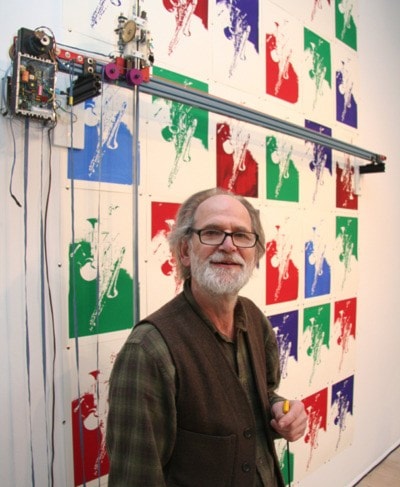Find out what can be done with the insides of five pianos, hundreds of found objects and a number of tiny motors in (CanonX+4:33=100), a newly-commissioned interactive installation running until April 28 at Open Space (510 Fort).
Picture this: A bright red ’80s-style joystick covered in wood panelling sits in the middle of the room surrounded by five colour-coded pianos. Every movement of the joystick is mirrored by a camera on an arm on the far left wall. The camera reads colour-coded screenprints that correspond to pianos of the same shade. Every movement sets off motors — engaging scrapers, ball bearings, files and other found objects in sequences created by internationally celebrated, Seattle-based sound sculptor Trimpin.
The result is a visual and audible feast of mechanical instrumentation.
“Every movement will have a completely different soundscape,” says Trimpin, who also built all the motors and appendages for the installation.
“You can’t order this anywhere,” says Trimpin, pointing to an unidentified “scraper” object affixed to one of the pianos. “There’s no mail order for this stuff.”
Part of the reason Trimpin moved to North America was because this type of “junk” is more readily available here than his native Germany, or Europe in general.
Open Space and UVic teamed up to commission the multimedia sculpture, which pays homage to two influential 20th century composers — John Cage and Conlon Nancarrow.
“People around Victoria donated five pianos, all fairly old and at the end of their life, not worth fixing,” says Kristy Farkas, concert manager at UVic’s school of music. Farkas was turned on to Trimpin by instructor and musician Andrew Schloss a few years ago when the documentary Trimpin: The Sound of Invention was screened at the Victoria Film Festival. At that time, Farkas was the new music coordinator at Open Space.
“I’ve always been interested in playing with sounds. Every object is an instrument,” says Farkas. “I don’t always like to play instruments in traditional ways. I always used to play with the inside of pianos and I really connected with his work. It’s very creative, playful, sculptural and imaginative.”
Farkas then invited Trimpin to Open Space.
“It’s taken a couple of years to get him here,” says Farkas. “He’s a really busy guy.”
Trimpin was the Lansdowne Scholar at UVic in 2004 where he worked with the students in the Music Intelligence and Sound Technology Interdisciplinary Centre teaching them how he interfaces acoustic instruments with computers.
“There’s a lot of interest from students,” says Trimpin. “And this is a discipline that you really need to apprentice. Over the last five to eight years I’ve worked at Stanford, M.I.T, and Princeton teaching a new discipline called music technology. When people hear music technology they think of recording techniques, but that’s not what we’re dealing with here.”
Trimpin became interested in interfacing acoustic instruments with computers after he suffered from an allergy that manifested in his mouth, which kept him from playing sax, tuba or the baritone horn.
“I couldn’t play anymore,” says Trimpin. “So I slowly decided to build sculpture pieces.”
“His work falls into a mixture of music and visual art,” says Schloss. “One of the things that makes him so special is his incredible visual sense.”
Schloss is a longtime fan and collaborator of Trimpin and he and some of his music students have been helping Trimpin build and set up the installation.
Schloss, other UVic faculty and students will take turns leading weekly talks for Plugging In: Talks on Sound, Technology & Art, running each week from March 24 through April 21. Presentations include George Tzanetakis: Music and technology throughout history (Sat., March 24 at 2 p.m.), Andrew Schloss: Approaching public art from a sonic perspective (Wed., April 4, 7:30 p.m.), Paul Walde: Composer as inventor (Sat., April 7 at 2 p.m.), Steeve A. Bjornson: Micro-controllers and their use in (CanonX+4:33=100), and Darren Miller: Invention on an invention — the compositional opportunities and challenges of writting for a Trimpin Installation (Sat., April 21at 2 p.m.). Tzanetakis is an Associate Professor in the Department of Computer Science. He is also Canada Research Chair (Tier II) in computer analysis, audio and music and in 2011 he was visiting faculty at Google Research. Walde is a multidisciplinary artist, musician, and curator and is new to the visual arts faculty this year.
There will be a specialist on site for demonstrations and questions every Thursday from 2 to 5 p.m.
The installation closes with a concert by MISTIC (Music Intelligence and Sound Technology Interdisciplinary Collective), a group of UVic students and faculty lead by Schloss, Friday, April 27 at 8 p.m.. MISTIC will use MIDI-enabled instruments to perform on the installation, bypassing the joystick and camera to create their own sequences. M
Trimpin
(CanonX+4:33=100)
Runs until April 28 at Open Space
(510 Fort)
